How to Make Sourdough Starter with Less Flour
I’ll teach you how to make Sourdough Starter from scratch without any commercial yeast. You need just 3 ingredients and 7-10 days to begin making real sourdough bread at home.
I’ve updated the process to use less than half the total amount of flour to create a lively and ready to use starter.
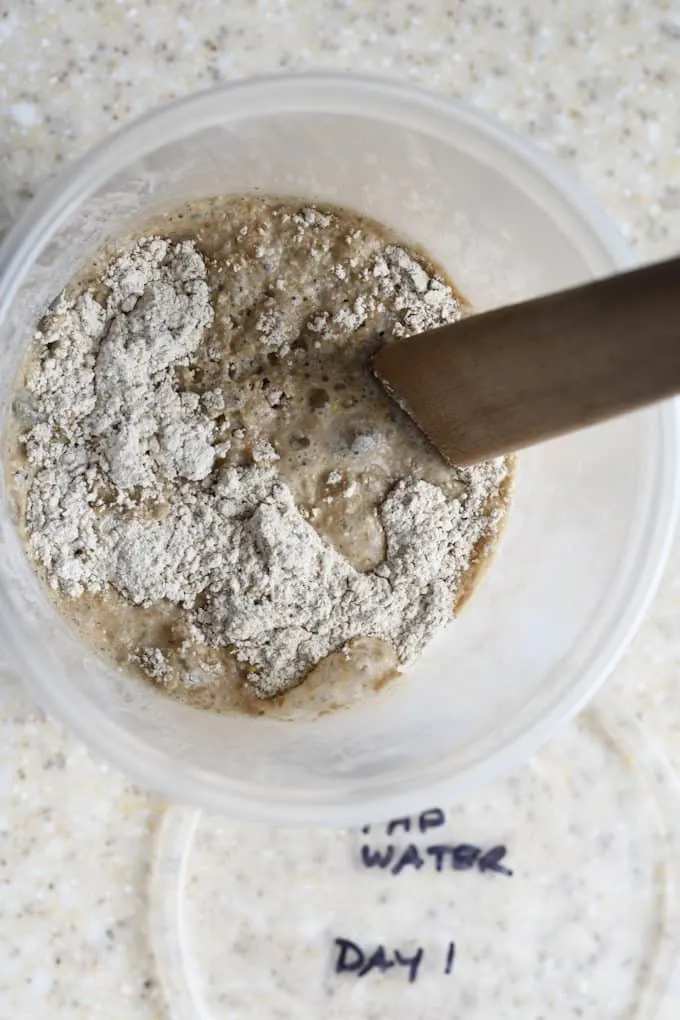
If you’re new to the world of sourdough baking, I’m so excited to get you “started” (pun intended!). Before you know it, I think you’ll be as obsessed as I am by the incredible living thing that is sourdough.
Yes, a sourdough starter is a living batter. It is built over several days to cultivate wild yeast from the environment and from the flour itself.
There are many ways to create and maintain sourdough starter. You may have read all sorts of warnings that you must use bottled water, that you should take it on vacation with you and treat it like a child. Relax, it’s really not that complicated.
I’m going to explain to you, step by step, how I created my starter. Along the way I’ll bust some myths about sourdough starters and, hopefully, show you that’s it’s really a very simple and forgiving process.
Once you have a starter, as long as you feed it periodically it can, theoretically, live forever.
How to make a sourdough starter using less flour
Although flour is usually inexpensive and easy to come by. It’s always good to create less waste.
So I revamped my process for creating a sourdough starter. With this new recipe the total amount of flour used is reduced from 30 oz (about 6 cups) down to less than 2 1/2 cups (12 oz).
The key is to keep the starter very small for the first 6 days of the process.
On day 7 we begin to bulk up the starter. By day 8, which is usually when the starter is active enough for baking, you’ll have a full 12 oz of starter. That’s enough to bake a loaf of bread and use what remains to continue feeding the starter.
All of my notes and photos for making a starter are still accurate with this smaller starter method.
Tips for making a successful Sourdough Starter:
- You don’t have to use bottled water to make sourdough starter. I mixed two starters side by side, one with bottled water and one with tap water. You can see in the process photos that they behaved exactly the same. As long as your tap water is good to drink and is not excessively chlorinated, there is no need to use bottled water. I baked with both starters with good results.
- I like to begin the starter with half all purpose and half whole grain rye flour. The wild yeast likes the extra nutrients in the whole grain flour.
- The whole grain flour gives the starter a bit of a boost and nice flavor, but if you can just all purpose flour is that’s what you have on hand.
- This is a 100% hydration starter. That simply means that it is made and replenished with equal weights of flour and water.
- For best results, weigh your ingredients. The weight of the flour can vary based on how you fill a measuring cup. Weight measurements are most consistent and accurate, especially when working with small amounts in the beginning of the process.
- The warmer the room, the faster your starter will activate. Since I was working in the winter months, I placed my starter near the furnace in our basement.
- About day 4 or 5, the starter may start to smell cheesy (like sour milk) and may not rise as much. Don’t give up! The smell will gradually become more yeasty/fermenty and less cheesy. It will sort itself out as random bacteria die out and the good yeasts take over.
- Use a plastic or glass container so you can see the progress of your starter. I like to use plastic, quart-size deli containers. They’re cheap and reusable. Get extra containers so you can transfer the starter to a clean container each time you feed it. They’re also handy for giving away starter to your baking friends.
- Once your starter is ready to go, you can bake with it right away.
Scroll through the step by step process photos to see how the starter looks each day:
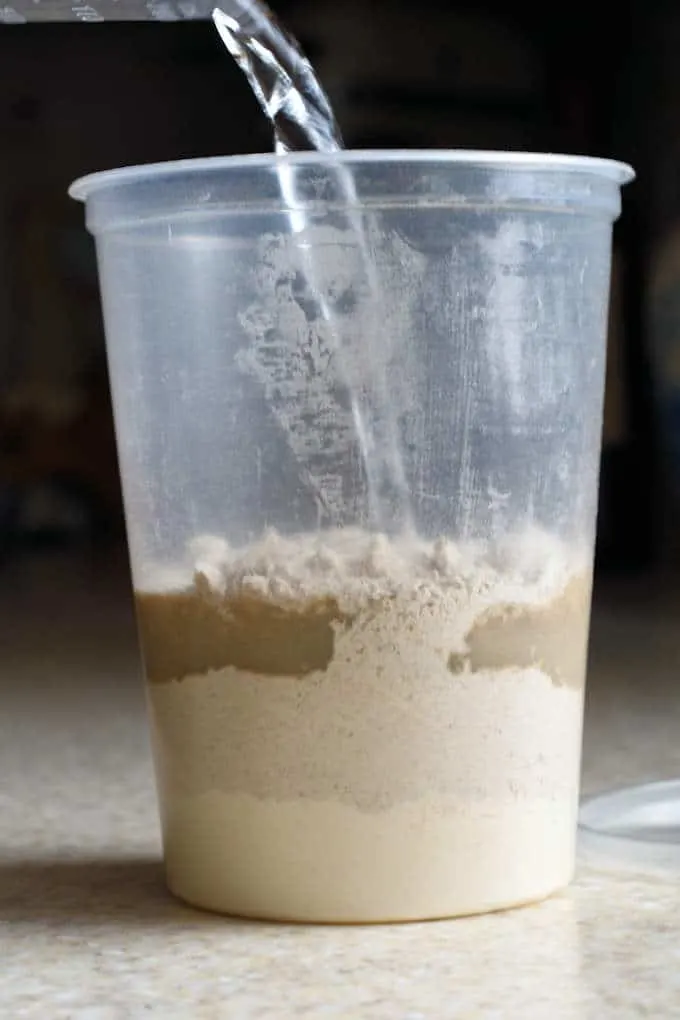
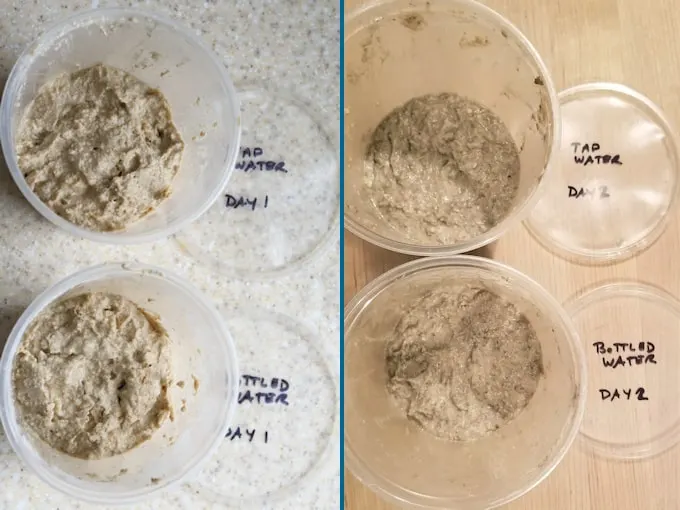
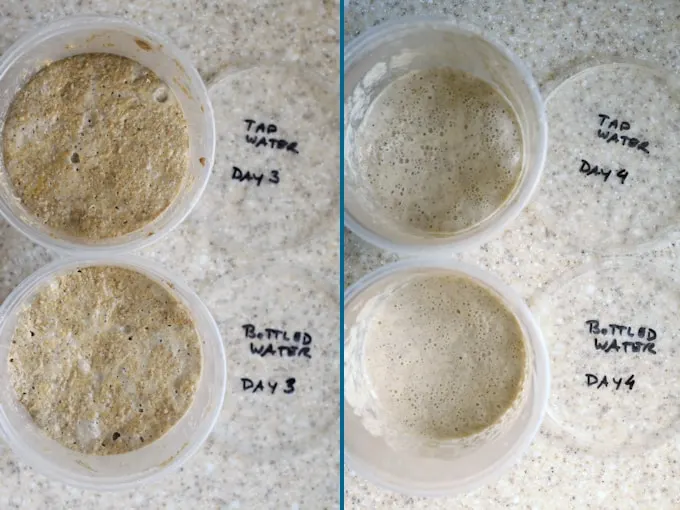
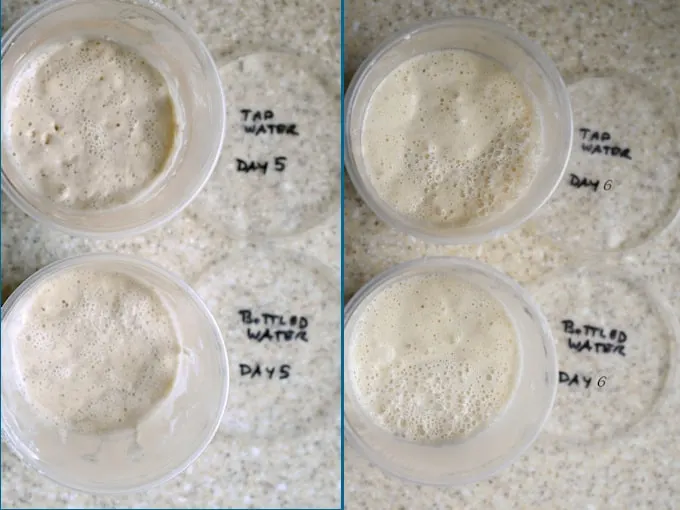
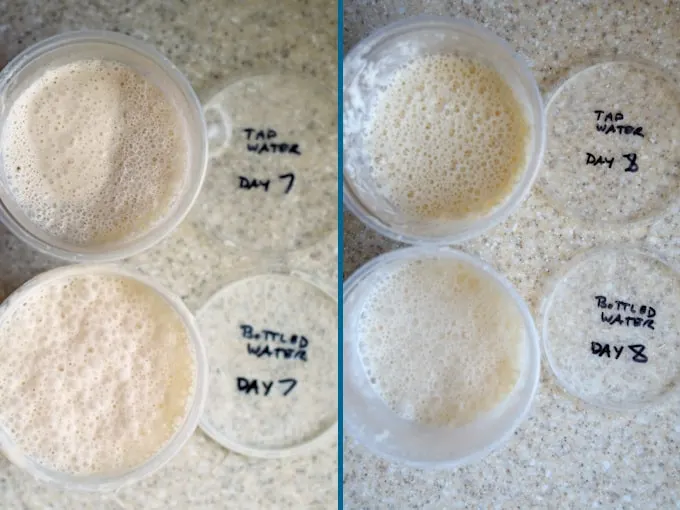
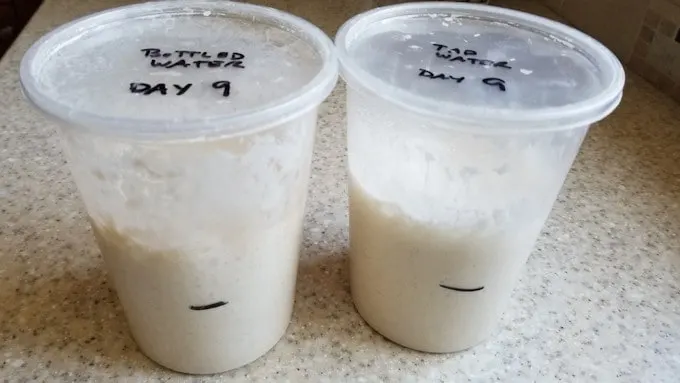
Daily Notes on My Sourdough Starter Progress:
- Day 1. Mixed at 11am.
- Day 2. No activity.
- Day 3. Doubled in volume, smells “grainy”, like wet rye. Not pungent. Fed at 11 am.
- Day 4. Rose to fill the container overnight, then collapsed. Smelled cheesy. Fed at 1 pm
- Day 5. Didn’t rise much, cheesy but less pungent, fed at 12 noon
- Day 6. Rose almost double. Smelled less cheesy, more sharp. Fed at 12 noon.
- Day 7. Rose to double and almost overflowed the container. No cheesy smell, just fermenty, yeasty smell.
- Day 8. Both rose to fill the container. No cheesy smell, smelled pleasantly fermented and yeasty. Ready to use.
- Day 9. Left at cooler room temp overnight. Rose to double in less than 6 hours and didn’t collapse by 24 hours. Nice yeasty, beery smell. First day baking.
Congratulations! You’ve done it! You’ve created a living batter filled with wild yeast. Now let’s see how to feed & maintain your sourdough starter. If you want to continue saving flour you can follow these instructions for How To Keep a Small Starter.
Now that you’ve got your starter ready, check out the entire list of My Best Sourdough Recipes. Have fun!
I know you hate to throw away that sourdough discard. Check out these recipes that use sourdough discard.
Finally, did you know you can dry your sourdough starter? It’s true. Dried starter can be stored at room temperature indefinitely without feeding.
If you love this recipe as much as I do, I’d really appreciate a star rating and a quick comment. Ratings and comments help my recipes show in search results. Thanks!
Sourdough Starter Recipe
Ingredients
- 1 oz unbleached all purpose flour
- 1 oz whole grain rye or whole wheat flour (see note)
- 2 oz water (room temperature)
- 10 oz unbleached all purpose flour (for feeding)
Instructions
- On Day 1, combine the all purpose flour, whole grain flour and water in a pint size glass or plastic container. Mix until it forms a thick batter. Loosely cover with plastic wrap or a lid.
- Set aside at warm room temperature (about 75°75 °F-80°F80 °F is ideal) until the mixture starts to bubble. The warmer the room temperature, the faster the starter will become active. This usually takes 48 hours, so there is no feeding on day 2.
- On day 3 weigh out 1 oz (28g) of the starter and discard the rest. Combine the reserved starter with 1 oz (28g) all purpose flour and 1 oz (28g) room temp water. Stir to form a thick batter, cover and set aside at warm room temperature for 24 hours. After 3 or 4 days the starter might smell cheesy. It’s fine. Keep feeding.
- On days 4, 5 and 6 feed with the same procedure. Weigh out 1 oz (28g) of the starter and discard the rest. Combine the reserved starter with 1 oz (28g) all purpose flour and 1 oz (28g) room temp water. Stir to form a thick batter, cover and set aside at warm room temperature for 24 hours.
- On day 7 weigh out 2 oz (56g) of the starter and discard the rest. Combine the reserved starter with 2 oz (56g) all purpose flour and 2 oz (56g) room temp water. Stir to form a thick batter, cover and set aside at warm room temperature for 24 hours.
- On day 8 you’ll need to transfer the starter to a quart size container. Weigh out 4 oz (112g) of the starter and discard the rest. Combine the reserved starter with 4 oz (112g) all purpose flour and 4 oz (112g) room temp water. Stir to form a thick batter, cover and set aside at warm room temperature for 6-24 hours.
- The starter is often ready at this point. The starter is ready to use for baking when it doubles in volume within 8 hours of feeding and has a pleasant, slightly fermented yeasty aroma. If that hasn’t happened by day 8 continue feeding until the starter is ready.
Would you like to save this recipe?
As an Amazon Associate and member of other affiliate programs, I earn from qualifying purchases.

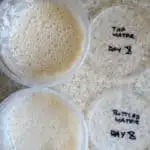

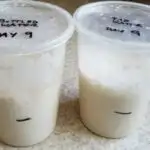



Hi Eileen
A couple of questions:
1- is the discarded starter just to keep the quantity at a reasonable amount? Do you have to discard in order to have a good starter?
2- I followed this recipe and am on day 9. I went to make the bagel recipe on your site but when I did the float test it sunk to the bottom. Does this mean my starter is no good? If so, Can it be rescued or do I have to start over?
Thanks
Mark
Hi Mark,
1-Yes. You don’t have to discard, but to keep the starter at 100% hydration (equal weights starter-water-flour) you need to discard or the starter will take over your house. To illustrate: Your starter is 12 oz. Without discarding you’d have to add 12 oz of water and 12 oz of flour to feed the starter and keep it at 100%. Now you have 36 oz. To feed that you’d have to add 36 oz of water and 36 oz of flour. Now you’ve got 108 oz, etc, etc, etc.
2-The starter is probably fine. But you should mix your dough when the starter is at peak activity. If the starter was fed 24 hours ago feed it again before mixing. I find that after about 3-6 hours the starter is at peak activity. Very bubbly and doubled or almost doubled in size. If you use the starter just before the 24 hour feeding it is still good, but will be less active. If you mix the dough with the less active starter it will probably take a little longer to ferment.
Hi Eileen, I have the exact same questions as Jim above actually! Would be great if you could help us out 🙂
Hi Laura. Jim asked the same question in another post and I answered him there. I didn’t realize the same question was on this post.
Here’s my answer:
The way I have my starter recipe written you should always have 12 oz of starter as your base. Each time you feed the starter you take out 4 oz of the unfed starter and combine it with 4 oz of flour and 4 oz of water. Discard (or use) the remaining 8 oz of starter. The main thing to remember is that you always feed with equal weights of starter-water-flour. That way the starter doesn’t get out of balance.
If you want to do a double bake in one day you could remove the 4 oz and feed. Set that aside as your base starter. You’re now left with 8oz. I would discard 2oz so you’re left with 6oz. Feed that 6oz with 6oz of water 6oz of flour. You’ll have a total of 18oz. When that starter is active and ready, use what you need for the two recipes and you should just have to discard the leftover 2oz. Does that make sense?
Let me know if you need further clarification.
Hello and thank you for the recipes and great tips.
I do need clarification about the starter: Each time the starter is to fed, are you to remove all but 4 oz. each time then feed that for 10 days? Or is the starter to be fed (without disgard) with the 4 oz. of flour & water?
I hate just to discard but i can see where there would be A LOT of starter.
One more, if i weigh out 8 oz. of starter to feed, is it plausible to add 8 oz. of flour and water?
I would like to make bread and pretzels the same day so i need to ensure that I have enough.
Many thanks for your article Eileen – You say use equal quantities of water & flour to feed the starter, and suggest it’s best to weigh it, but your amounts aren’t equal.
I use the ‘extra’ starter to make muffins, pizza dough, etc – lots of recipes across the internet for the amount that’s discarded each time.
Some sour dough bread recipes use unfed starter too.
We love sour dough bread but must leave 2 days to make it properly and we make small loaves as in the heat where we live, it is best eaten across 2-3 days.
Hi Dorothy. The amounts are equal. The all purpose and rye flour add up to 6 oz of flour and then you add 6 oz of water. Yes, there are lots of “discard” recipes out there. I have several myself. You could start a bread recipe with unfed starter, you just have to allow the time at the beginning to get the starter going. Which is essentially the same thing as “feeding” it. What I love about working with sourdough is that the process allows, in fact requires, lots of leeway.
Hi, great article, thank you! So, how does one use the sourdough starter once it is available to use? If a bread recipe calls for, example, 1 cup of flour, and 1 cup of water, etc… when, and how does the starter get used? I am confused, NAD, can’t wait to start. I have unseccessfully tried to make this a couple of times in the past, but gave up.
Hi Craig, to start with I would use arecipe written for using sourdough starter. Once you’re comfortable using starter, you can try adapting some regular recipes to use starter instead of yeast. A cup of starter should replace 4oz of water and 4oz of flour in a recipe, or about a 1/2 cup of each.
4 0z. of water more or less fills a 1 cup measuring cup. I did this as an experiment (I weigh my ingredients). For readers who don’t weigh ingredients, I suggest a scant cup of water.
A cup of water is 8 fluid oz and weighs 8 oz. If you use a scant cup of water you’ll be adding closer to 6 or 7 oz of water and your starter won’t be properly balanced. Also, make sure you are using liquid measuring cups, not dry measuring cups.
I’m on day 7. Since feeding it today it has risen much better,but up until today it seems to rise a at the start and then has collapsed with a watery residue on top. When I come to feed it the next day its always very runny. I’m not sure if this is normal? What consistency should it be when it’s ready?
Keeping my fingers crossed it will come together towards the end!
Hi Becky, what you’re describing is normal. The texture of the starter will change as it goes through the feeding cycle. If yours is rising & falling very fast it might be extra hungry. You can try feeding it 2x per day.
That’s great, thank you! What should the consistency be like when it is ready to use?
Like a very thick batter or very thin dough.